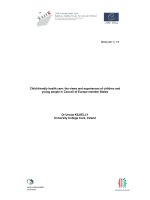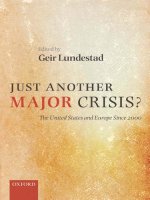- Trang chủ >>
- Khoa Học Tự Nhiên >>
- Vật lý
pleistocene amphibians and reptiles in britain and europe jun 1998
Bạn đang xem bản rút gọn của tài liệu. Xem và tải ngay bản đầy đủ của tài liệu tại đây (13.86 MB, 265 trang )
OXFORD
MONOGRAPHS
ON
GEOLOGY
AND
GEOPHYSICS
Series Editors
H.
Charnock
J.
R
Dewey
S.
Conway
Morris
A.
Navrotsky
E. R.
Oxburgh
R.
A.
Price
B. J.
Skinner
OXFORD
MONOGRAPHS
ON
GEOLOGY
AND
GEOPHYSICS
1.
DeVerle
P.
Harris: Mineral Resources Appraisal: Mineral Endowment, Resources,
and
Potential
Supply:
Concepts, Methods,
and
Cases
2.
i. ].
Veevers
(ed.):
Phanerozoic Earth History
of
Australia
3.
Yang Zunyi, Cheng
Yuqi,
and
Wang
Hongzhen
(eds.):
The
Geology
of
China
4.
Lin-Gun
Liu and
William
A.
Bassett:
Elements, Oxides,
and
Silicates:
High-Pressure Phases with Implications
for the
Earth's
Interior
5.
Antoni
Hoffman
and
Matthew
H.
Nitecki
(eds.):
Problematic Fossil
Taxa
6.
S.
Mahmood
Naqvi
and
John
J. W.
Rogers: Precambrian Geology
of
India
1.
Chih-Pei Chang
and T. N.
Krishnamurti
(eds.):
Monsoon Meteorology
8. Zvi
Ben-Avraham
(ed.):
The
Evolution
of
the
Pacific
Ocean Margins
9. Ian
McDougall
and T.
Mark Harrison:
Geochronology
and
Thermochronology
by
the
40
Ar/
39
Ar
Method
10.
Walter
C.
Sweet:
The
Conodonta:
Morphology,
Taxonomy,
Paleoecology,
and
Evolutionary History
of
a
Long-Extinct Animal Phylum
11.
H. J.
Melosh: Impact
Cratering:
A
Geologic Process (now
in
paperback)
12.
J. W.
Cowie
and M. D.
Brasier
(eds.):
The
Precambrian-Cambrian
Boundary
13. C. S.
Hutchinson: Geological
Evolution
of
South-East
Asia
14.
Anthony
J.
Naldrett:
Magmatic
Sulfide
Deposits
15. D. R.
Prothero
and R. M.
Schoch
(eds.):
The
Evolution
of
Perissodactyls
16.
M.
Menzies
(ed.):
Continental Mantle
17. R. J.
Tingey
(ed.):
Geology
of
the
Antarctic
18.
Thomas
J.
Crowley
and
Gerald
R.
North:
Paleoclimatology (now
in
paperback)
19.
Gregory
J.
Retallack: Miocene Paleosols
and Ape
Habitats
in
Pakistan
and
Kenya
20.
Kuo-Nan Liou: Radiation
and
Cloud Processes
in the
Atmosphere:
Theory,
Observation
and
Modeling
21.
Brian Bayly: Chemical Change
in
Deforming
Materials
22. A. K.
Gibbs
and C. N.
Barron:
The
Geology
of
the
Guiana Shield
23.
Peter
J.
Ortoleva:
Geochemical
Self-Organization
24.
Robert
G.
Coleman:
Geologic Evolution
of
the Red Sea
25.
Richard
W.
Spinrad, Kendall
L.
Carder,
and
Mary Jane Perry: Ocean Optics
26.
Clinton
M.
Case: Physical Principles
of
Flow
in
Unsatura
ted
Porous Media
27.
Eric
B.
Kraus
and
Joost
A.
Businger: Atmosphere-Ocean Interaction,
Second Edition
28. M.
Solomon
and D. I.
Groves:
The
Geology
and
Origins
of
Australia's Mineral
Deposits
29. R. L.
Stanton:
Ore
Elements
in Arc
Lavas
30. P.
Wignall:
Black Shales
31.
Orson
L.
Anderson: Equations
of
State
for
Solids
in
Geophysics
and
Ceramic Science
32. J.
Alan Holman: Pleistocene Amphibians
and
Reptiles
in
North America
33. P.
Janvier: Early Vertebrates
34.
David
S.
O'Hanley: Serpentinites: Recorders
of
Tectonic
and
Petrological History
35.
Charles
S.
Hutchison: South-East Oil, Gas, Coal
and
Mineral Deposits
36.
Maarten
J. de Wit and
Lewis
D.
Ashwal
(eds.):
Greenstone Belts
37.
Tina Niemi,
Zvi
Ben-Avraham,
and
Joel
R.
Gat:
The
Dead Sea:
The
Lake
and
Its
Setting
38. J.
Alan Holman: Pleistocene Amphibians
and
Reptiles
in
Britain
and
Europe
PLEISTOCENE
AMPHIBIANS
AND
REPTILES
IN
BRITAIN
AND
EUROPE
J.
Alan
Holman
New
York
•
Oxford
Oxford
University Press
1998
Oxford
University Press
Oxford
New
York
Athens
Auckland Bangkok Bogota Bombay
Buenos Aires Calcutta Cape
Town
Dar es
Salaam
Delhi Florence Hong Kong Istanbul Karachi
Kuala
Lumpur Madras Madrid Melbourne
Mexico City Nairobi Paris Singapore
Taipei Tokyo Toronto Warsaw
and
associated companies
in
Berlin
Ibadan
Copyright
©
1998
by
Oxford University
Press,
Inc.
Published
by
Oxford University
Press,
Inc.
198
Madison Avenue,
New
York,
New
York 10016
Oxford
is a
registered trademark
of
Oxford University Press.
All
rights reserved.
No
part
of
this publication
may be
reproduced,
stored
in a
retrieval
system,
or
transmitted,
in any
form
or by any
means,
electronic,
mechanical, photocopying,
recording,
or
otherwise,
without
the
prior permission
of
Oxford University
Press.
Library
of
Congress
Cataloging-in-Publication
Data
Holman,
J.
Alan, 1931-
Pleistocene
amphibians
and
reptiles
in
Britain
and
Europe
/
J.
Alan Holman.
p. cm.
Includes
bibliographical references
and
index.
ISBN
0-19-511232-6
1.
Amphibians,
Fossil—Europe.
2.
Reptiles,
Fossil—Europe.
3.
Amphibians,
Fossil—Great
Britain.
4.
Reptiles,
Fossil—Great
Britain.
5.
Paleontology—Pleistocene.
I.
Title.
QE867.H63
1998
567'.S'094—
dc21
97-30058
1
35798642
Printed
in the
United States
of
America
on
acid-free
paper
PREFACE
The
Pleistocene
epoch,
or Ice
Age,
an
extended period
of
advancing
and re-
treating
continental
ice
sheets,
is
characterized
by
striking climatic oscillations
and
sea
level
fluctuations.
This
age
saw
the
rise
and
spread
of
humans
and a
great extinction
of
large mammals
by
the
end of the
epoch.
In
fact,
the
world
today
is
essentially
the
product
of
dramatic changes that took
place
in the
Pleis-
tocene. Major works have dealt with Pleistocene mammals
in
North America
and
Europe
and the
"why"
of the
worldwide mammalian extinction. Moreover,
a
recent book (Holman, 1995c)
has
dealt with North American
Ice Age am-
phibians
and
reptiles.
Yet no
comparable work deals with British
and
European
Pleistocene hcrpetofaunas. This book attempts
to
address this
situation
by fo-
cusing
on the
Pleistocene amphibians
arid
reptiles
in
Britain
and the
European
continent eastward through Poland,
the
Czech Republic, Hungary, Yugoslavia,
and
Greece.
The
book begins with
an
overview
of the
Pleistocene
epoch
and its
signifi-
cance, followed
by a
general discussion
of the
Pleistocene
in
Britain
and
Europe
in
Chapter
2,
with emphasis
on
regional terms used
to
define
Pleistocene chron-
ological
events. Chapter
3
looks
at the
pre-Pleistocene
herpetofauna
of
the
study
area
to set
the
stage
for a
discussion
of the
Pleistocene herpetofauna.
A
large
portion
of the
book consists
of a
"Bestiary"
(Chapter
4), a
series
of
annotated
taxonomic accounts
of
Pleistocene
herpetological
taxa from
the
region. Illustra-
tions
of
bones that
are
especially
useful
in the
identification
of
Pleistocene
her-
petological species
arc
included
in
many
of
these accounts, along with
a
discussion
of
important characters used
in the
identification
of
Pleistocene spe-
cies.
A
list
of
locality numbers
for
each taxon
in the
Bestiary correlates with
those
of
localities detailed
in
Chapter
5.
These accounts contain lists
of
herpe-
tological
species, literature references, and. when appropriate, remarks about
the
site.
Following this
is the
interpretive section.
It
begins with
a
discussion
of
her-
petological species
as
paleoenvironmental
indicators
in
Chapter
6.
Next, Chapter
7
analyzes herpetological population adjustments
to
Pleistocene events
in
Britain
and
Europe. Chapter
8
follows with
a
discussion
of
extinction patterns
in the
vi
PREFACE
region, including
a
dialogue about
the
apparent evolutionary stasis
of the
Pleis-
tocene herpetofauna
compared
with avian
and
mammalian populations. Finally,
Chapter
9
discusses
the
differences
and
similarities between Pleistocene herpe-
tological
events
in
Britain
and
Europe
and
North America.
This
book
is
meant
to be a
college-level introduction
to the
study
of
Pleis-
tocene amphibians
and
reptiles
of
Britain
and
Europe
and a
companion volume
to
Pleistocene
Amphibians
and
Reptiles
in
North
America
(Holman,
1995c).
It
does
not
pretend
to be a
definitive
taxonomic revision
of
Pleistocene herpeto-
logical taxa
or
claim
to
cite every reference
for
each Pleistocene herpetological
species
found
in the
vast area covered
by the
book.
It
should, however,
be a
standard
reference
for
anyone interested
in
Pleistocene
flora or
fauna
as
well
as
Pleistocene events
in
general.
It
should
be
especially
useful
for
modern herpe-
tologists,
ecologists,
and
evolutionary biologists.
I
have tried
to
keep
the ap-
proach
to the
subject simple
and
direct
and
have
purposely
tried
not to get
involved
in
esoteric
and
convoluted
arguments about Pleistocene events
and
patterns.
East
Lansing,
Mich.
J.A.H.
ACKNOWLEDGMENTS
I
gratefully acknowledge
the
persons
who
have been especially helpful
in the
preparation
of
this book. Many have been hosts
for my field and
museum stud-
ies,
and
others
have
loaned
herpetological
fossils
or
modern
comparative
skel-
etons.
All
have supplied technical correspondence and/or publications:
N.
Ashton (London),
W.
Auffenberg (Gainesville),
S.
Balcon
(Tunbridge-Wells),
M.
Benton (Bristol),
G.
Bohme
(Berlin),
S.
Chapman (London),
J.
Clayden (East
Runton-Cromer),
J.
Clack (Cambridge),
A.
Currant (London),
R.
Estes (San
Diego),
E.
Fritz (Dresden),
D.
Harrison (Seven Oaks),
M.
Ivanov (Brno),
T.
Kemp (Oxford),
T. v.
Kolfschoten (Leiden),
L.
Kordos (Budapest),
A.
Milner
(London),
M.
Mlynarski
(Krakow),
S.
Parfitt
(London),
M.
Paunovic
(Zagreb),
J.
C.
Rage (Paris),
M.
Roberts (London),
Z.
Rocek
(Prague),
B.
Sanchiz (Ma-
drid),
A.
Stuart (Norwich),
Z.
Szyndlar (Krakow),
and M.
Warren (Cromer).
Diane Baclawski
of the
Geological Sciences Library
at
Michigan
State
Uni-
versity
helped gather
Pleistocene
herpetological
literature.
I
thank Joyce Berry, Nancy Hoagland, Jessica
A.
Ryan,
and the
other editorial
staff
of
Oxford University
Press,
New
York,
for
their
efforts
in the
production
of
this book.
The
National
Geographic
Society provided recent grants
for field-
work
and
museum studies
for
this work.
I
especially thank
Teresa
Petersen
for
the
preparation
of figures.
Other
artists
are
acknowledged
in the
figure legends.
This page intentionally left blank
CONTENTS
1
Introduction
3
2 The
Pleistocene
in
Britain
and
Europe
6
3 The
European Herpetofauna: Paleocene Through Pliocene
10
4 A
Bestiary—Annotated
Taxonomic Accounts
20
5
Pleistocene Herpetological Localities
130
6
Herpetological Species
as
Paleoenvironmental Indicators
201
7
Herpetological Population
Adjustments
in
the
Pleistocene
of
Britain
and
Europe
207
8
Extinction Patterns
in the
Herpetofauna
of the
Pleistocene
of
Britain
and
Europe
217
9
Pleistocene Events
in the
Herpetofaunas
of
Britain
and
Europe,
and
North
America Compared
224
References
228
General Index
249
Taxonomic
Index
251
Site Index
252
This page intentionally left blank
PLEISTOCENE
AMPHIBIANS
AND
REPTILES
IN
BRITAIN
AND
EUROPE
This page intentionally left blank
1
INTRODUCTION
There
is
disagreement about
the
time
of the
beginning
of the
Pleistocene.
For
instance, Repenning (1987),
a
North American, puts
the
beginning date
at 1.9
million
ybp.
On
the
other
hand, some modern Europeans studying
the
subject
(e.g., Gibbard
et
al.,
1991;
Kolfschoten
and
Meulen,
1986;
Roebroeks
and
Kolf-
schoten,
1995;
Zagwijn,
1985, 1992)
consider
the
epoch
to
have
begun
about
2.3
million
ybp.
The
system used here, however,
follows
Sanchiz
(in
press),
who
accepts
the
official
usage
of
Harland
et al.
(1990),
who put the
beginning
of
the
Pleistocene
at
1.64
million
ybp.
Evidence that
the
Pleistocene ended about
10,000
ybp
(Meltzer
and
Mead,
1983)
is
widely accepted. This ending date
correlates
very
closely with
the
terminal extinction
of
many large land mammal
species.
The
Pleistocene
is
characteri/ed
by
climatic oscillations
and a
series
of
glacial
and
interglacial events where great continental
ice
sheets advanced
and
retreated
many
times.
The ice
sheets were massive forces, sculpting
the
topography
of
the
land
and
carrying much sedimentary material, including huge boulders
and
even megablocks
of
land
up to 4 km in
diameter,
as far as 250 km in the
Canadian prairies (MacStalker,
1977).
In
Britain
and
Europe,
as
well
as in
North
America,
the
advance
and
retreat
of ice
sheets
had a
marked
effect
on the
dis-
tribution
of
plant
and
animal
life.
Huge tracts
of
habitat were alternately oblit-
erated
and
reopened several times,
but
other
effects
perhaps
arc not so
well
known.
For
instance, during glacial times,
so
much atmospheric water
was
tied
up
in the
formation
of
the
ice
that
sea
levels
worldwide lowered markedly.
On
the
other hand,
sea
levels rose during
interglacial
times when
water
was
melting
off
the ice
sheets.
The
most interesting
and
controversial biological event that took place
in the
Pleistocene
was the
sudden, almost worldwide, extinction
of
large land
mam-
mals,
and to a
lesser extent birds, that took place
by the end of the
epoch
10,000
years
ago.
At
least
200
mammalian genera
became
extinct, among them large
herbivores,
the
carnivores that preyed
on
them,
and the
scavengers that
fed on
the
remains
of
both groups. Some
of
the
striking kinds
of
mammals that became
3
4
PLEISTOCENE
AMPHIBIANS
AND
REPTILES
IN
BRITAIN
AND
EUROPE
extinct
in
Britain
and
Europe
in the
late Pleistocene (Stuart,
1991)
were
the
cave
bear
(Ursus
spelaeus);
the
spotted hyena
(Crocuta
crocuta),
which
presently
survives
elsewhere;
the
wooly
mammoth
(Mammuthus
primigenius);
the
straight-tusked
elephant
(Palaeoloxodon
antiquus);
one or two
species
of
extinct
nonwooly rhinoceroses
of the
genus
Dicerorhinus;
the
wooly rhinoceros (Coe-
lodonta
antiquitatis);
one or two
species
of
horses
of the
genus
Equus;
the
hippopotamus
(Hippopotamus
amphibius),
which presently
survives
elsewhere;
the
giant deer
(Megaloceros
giganteus);
and an
extinct bison (Bison
priscus).
Much
discussion
and
debate concerning
the
extinction
of the
"mammalian
megafauna"
has
taken place over
the
past decades
(e.g.,
Martin
and
Wright,
1967; Martin
and
Klein, 1984; Stuart,
1991),
with
the
main issue being whether
the
rise
of
human
big
game hunters
or
changing environmental conditions were
the
major
causes.
But
suprisingly
few
works have addressed
the
other vertebrate
classes
and
their role
in the
complex events
of the
Pleistocene,
and no
summary
works have
been
written about
the
Pleistocene
herpetofauna
of
Britain
and Eu-
rope. This book, then, deals
with
a
discussion
of the
Pleistocene herpetofauna
of
the
British Islands
and the
European continent east through Poland,
the
Czech
Republic, Hungary, Yugoslavia,
and
Greece.
This study
area
includes
the
fol-
FIGURE
I. Map of the
region covered
by
this book (except
for the
Spanish Canary
Is-
lands).
INTRODUCTION
5
lowing
political entities: Ireland, Great Britain, France
and its
oceanic islands,
Monaco, Spain
and its
oceanic islands,
the
Netherlands, Belgium, Luxembourg,
Germany, Austria, Switzerland, Poland, Czech Republic, Italy
and its
oceanic
islands
(as
well
as
Malta), Hungary, Yugoslavia (Croatia, Bosnia, Serbia),
and
Greece
and its
oceanic islands (Fig.
1).
The
fact that
the
terms
"Britain"
and
"Europe"
are
used
as
separate entities
in
the
title
of
this book, rather than merely referring
to
"Pleistocene
amphibians
and
reptiles
in
Europe,"
is
meant
to
reflect
the
unique position
of the
British
Islands
in the
Pleistocene
and
early Holocene. These islands represent
a
large
land
mass that
was
connected
to
continental Europe
during
much
of the
Pleis-
tocene, only
to
become
separated
from
the
larger
land
mass soon
after
the end
of
the
epoch.
As it
happens,
the
herpetofauna
of
Britain
and
Europe
was
quite stable
during
the
Pleistocene compared
to the
mammalian
fauna,
which suffered
familial,
ge-
neric,
and
specific extinction (Stuart, 1991).
A
compelling question, then,
is
"What
attributes have allowed
the
herpetofauna
to
survive
the
stresses that
caused
dramatic extinctions
in the
mammalian
fauna
of the
Pleistocene?"
This
question
is
addressed
after
a
review
of the
British
and
European Pleistocene
herpetofauna,
and a
consideration
of
herpetological range
adjustments
and ex-
tinction
patterns
in the
Pleistocene. Finally, herpetological events
in
Britain
and
Europe
and
North America
are
compared.
The
following
chapter
is a
discussion
of
the
Pleistocene
in
Britain
and
Europe with
an
emphasis
on
terms that
are
presently
used
to
designate Pleistocene chronological events
in the
area (Fig.
1)
covered
by
this book.
2
THE
PLEISTOCENE
IN
BRITAIN
AND
EUROPE
A
general introduction
to the
Pleistocene with
an
emphasis
on
herpetological
remains
was
presented
in the
companion volume Pleistocene
Amphibians
and
Reptiles
in
North
America
(Holman, 1995c).
For a
general introduction
to the
Pleistocene that gives much attention
to
Britain
and
Europe,
the
reader
is re-
ferred
to
Sutcliffe
(1985).
A
detailed account
of
Pleistocene
mammals
in
Britain
is
given
by
Stuart
(1982),
and a
general
account
of
Pleistocene mammals
in
Europe
is
given
by
Kurten
(1968).
The
present chapter deals mainly with chron-
ological
divisions
of the
Pleistocene
in
Britain
and
Europe.
Early geologists recognized that
glacial
deposits
and
land forms existed
far
south
of
existing
glaciated areas,
and
they correctly reasoned that these
features
indicated
not
only
the
presence
of ice
sheets
but the
onset
of
cold climates,
as
well.
As
these features
were
mapped
and
stratigraphic studies
were
made,
it was
found
that some sections contained weathered zones
of
organic
soils
and
plant
remains between layers
of
glacially derived
sediments.
It was
suggested that
these organic zones
represented
nonglacial environments
and
that
ice
sheets must
have
advanced
and
retreated several times.
In
Europe,
before
studies
of
deep
sea
sediments were made,
Pleistocene
chronological events were determined
on the
basis
of
piecemeal evidence from
terrestrial
sediments.
The
earliest widely accepted chronology
of
climatic Pleis-
tocene intervals
was the
classic
fourfold
subdivision
of
Pleistocene glacial events
in
the
Alps
by
Penck
and
Bruckner (1909).
These
glacial stage names, from
oldest
to
youngest,
are
Gu'nz
glacial, Mindcl glacial,
Riss
glacial,
and
Wiirm
glacial. Between
the
glacial
stages,
intcrglacial stages were designated
by
com-
pound
names based
on the
underlying
and
overlying glacial stages (e.g.,
The
Gunz-Mindel
intcrglacial
stage
lies between
the
Giinz
and
Mindel glacial
stages).
These
Alpine glacial stages have been widely used,
and one
still
finds
references
to
them (especially
the
younger stages)
in the
recent literature (e.g.,
Fritz,
1995).
Other
local
chronologies were
set up in
other regions
and
continents (e.g.,
Table
1), and for a
time
it
appeared that
the fourfold
subdivision
of the
Alpine
6
THE
PLEISTOCENE
IN
BRITAIN
AND
EUROPE
7
Table
1.
Pleistocene
Stage
Names
Butch/European
1.
Weichselian
G
2.
Eemian
I
3.
Saalian
G
4.
Holstcinian
I
5.
Elstcrian
G
6.
Cromcrian
I
7.
Alps
Wiirm
G
Riss-Wiirm
I
Riss
G
Mindel-Riss
I
Mindel
G
Giinz-Mindel
I
Giinz
G
Britain
Devcnsian
G
Ipswichian
J
Wolstonian
G
Hoxnian
I
Anglian
G
Cromerian
I
Beestonian
G
North
America
Wisconsinan
G
Sangamonian
1
Illinoian
G
Yarmouthian
J
Kansan
G
Aftonian
I
Nebraskan
G
Note:
Stages below
2 do not
necessarily
correlate laterally. G=Glacial,
l =
Interglacial.
system
could
be
matched
in
other areas.
But
through
the
years
it
became
ap-
parent that exact correlation
of
temporal units, especially older ones, could
not
be
accomplished
in
different
regions. Then,
as
more time elapsed,
it
became
obvious that
the
continental chronologies were
far too
simple. Evidence from
deep
sea
sediments, correlated with
paleomagnelic-dated
loess sequences
in Eu-
rope, indicated that
the
classical sequence
of
four
glacial-interglacial stages
in
the
Alps covered
at
least eight stages, going back only
to a
marine stage dated
at
about
800,000
ybp
(Kukla,
1970, 1977). Moreover,
it was
found
that
the
supposed interglacial stages actually represented periods
of
crustal movement
and
not
climatic events. Kukla (1977) argued that
the
classical Alpine termi-
nology should
be
abandoned
in
interregional correlations, which
he
suggested
should
be
based
on the
oxygen isotope dates
in
the
deep
sea
sediments. Thus,
at
present, there
is a
tendency
for
more
and
more Quaternary paleontologists
to
try
to
correlate
the
terrestrial evidence with
the
paleomagnetically dated chro-
nology
of the
deep
sea
cores.
Yet the use of
chronological terminology originally based
on the
classic con-
cept
of
glacial
and
interglacial events
is
still very much alive. Three sets
of
stage
names,
the
Alpine,
the
Dutch/European,
and the
British
Tsles
system (Table
1)
continue
to be
used
by
European vertebrate paleontologists, with
the
Dutch/
European
and
British chronologies most frequently used.
In the
three systems,
the
Upper Pleistocene last glacial-interglacial stage sequences
correlate
fairly
well.
The
last
interglacial
stages (Alpine: Riss-Wiirm; Dutch/European: Eemian;
British
Islands: Ipswichian) began approximately
120,000
ybp and
ended
ap-
proximately
110,000
ybp.
The
last
glacial stages (Alpine: Wiirm;
Dutch/
European: Weichselian; British Island: Devensian) began approximately
110,000
ybp
and
ended
10,000
ybp at the end of the
Pleistocene (Stuart, 1982, 1988).
It
has
been suggested that glacial ages
are
usually
of
much longer duration
than
interglacial ages.
In
fact,
palcoclimatologists point
out
that
the
present tem-
perate
age has
continued
for
10,000
years,
and
that
if the
frequency
of
previous
glacial-interglacial cycles
is a
model
for
future
events,
the
earth could
go
into
another glacial cycle very
quickly
(see references
in
Sutcliffe,
1985,
pp.
213-
214). This would
have
tremendous
ramifications
for the
herpetofauna
in the
northern latitudes,
not to
mention human
and
other mammalian populations!
8
PLEISTOCENE
AMPHIBIANS
AND
REPTILES
IN
BRITAIN
AND
EUROPE
FIGURE
2.
Correlation
of
Lower
and
Middle Pleistocene beds
in
Britain
(East
Anglia)
and
The
Netherlands.
[Interpretations
arc
from
Gibbard
et
al.,
1991]
Since
it has
been very
difficult
to
accurately correlate
the
earlier (Lower
and
Middle Pleistocene) chronological
units
in
Europe,
a
team
of
British
and
Dutch
scientists
met in
Norwich, England,
in
1988
to
discuss establishing correlations
of
Lower
and
Middle Pleistocene stages across
the
southern North Sea.
These
correlations
were
attempted
on the
basis
of
floral, faunal,
and
paleoclimatic
data.
The
results
of
this meeting were recently published (Gibbard
et
al.,
1991). This
scheme (Fig.
2) has the
Pleistocene
beginning much earlier than
the one
used
here, which considers
the
Lower
Pleistocene
to
begin
at
about
the
base
of the
Netherlands Eburonian
and the
British
Beestonian.
Nevertheless,
the
Middle
Pleistocene correlations
in
Figure
2 are of
considerable interest. Note that
the
type section
of the
British
Cromerian
interglacial
stage
roughly
correlates with
the
upper three interglacial stages
of the
continental
"Cromerian
Complex."
Later
works (e.g.,
Kolfschoten
and
Turner,
1996)
have shown that specific Brit-
ish
"Cromerian"
localities specifically
correlate
with specific
"Cromerian
Com-
plex"
localities
in the
Netherlands,
and
these studies continue.
It is
highly
probable that
the
British
Anglian
glacial
stage
correlates with
the
Netherlands
THE
PLEISTOCENE
IN
BRITAIN
AND
EUROPE
9
(=Dutch/European)
Elsterian glacial stage
and
that
the
British Hoxnian inter-
glacial stage correlates with
the
Netherlands
(=Dutch/European)
Holsteinian
interglacial stage.
Roberts
et
al.
(1995), based
in
part
on the
proceedings
of the
European Sci-
ence
Foundation Workshop
at
Tautavel, France,
in
1993
on the
earliest occu-
pation
of
Europe
by
humans, correlated several British Cromerian sites
(including
two
important herpetological sites,
the
Boxgrove
and
Westbury-Sub-
Mendip) with
the
Cromerian
IV
interglacial
of the
Dutch/European
sequence.
Also important, they point
out
that
the
stratigraphic record
in
Britain between
the
Anglian
and
Ipswichian (see Table
1) has
been oversimplified, mainly
be-
cause
of too
much
reliance
on
palynological studies.
In
reality,
there
are
prob-
ably
at
least
two
temperate stages rather than
the
present single Hoxnian stage
in
this interval. British Pleistocene herpetological sites have been important
in
some
of
these interpretations.
Sutcliffe
(1985) astutely points
out
that
"glacials
and
interglacials have
tended
to
become rigid
'boxes'
into which
all
climatic events have
to be fitted"
(p.
61).
In the
Netherlands,
for
instance,
36
major
and
minor climatic cycles
have been recorded
in the
Pleistocene, with seven cycles being observed
in the
last
(Weichselian) glacial sequence alone (Kolfschoten
and
Turner, 1996).
The
reader should
be
alerted that
in the
herpetological literature some assignments
of
European Pleistocene herpetological sites
to
traditional glacial
and
interglacial
stages
may
have been
oversimplified.
This book
follows
Sanchiz
(in
press)
in
arranging herpetological sites under
"Lower
Pleistocene,"
"Middle
Pleistocene,"
and
"Upper
Pleistocene"
head-
ings
(Table
2),
with some sites merely being listed
as
"Pleistocene
Undesig-
nated."
More
restrictive chronological divisions
are
pointed
out in
remarks
on
some
of the
sites
in
Chapter
5.
Sanchiz followed
the
official
usage
of
Harland
et al.
(1990).
The
reader should
be
reminded again that other publications (e.g.,
Repenning, 1987; Gibbard
et
al.,
1991) indicate
an
earlier beginning
of the
Pleistocene.
Table
2.
Time span
of the
Lower, Middle,
and
Upper
Pleistocene
Used
in
This Book
Time
Period
Years
before Present (ybp)
Lower
Pleistocene
1.64
million
to
700,000
ybp
Middle
Pleistocene
700,00-127,000
ybp
Upper
Pleistocene
127,000-10,000
ybp
Note:
Time
designations
are
based
on
Sanchiz
(in
press).
3
THE
EUROPEAN
HERPETOFAUNA
Paleocene
Through
Pliocene
In
both Europe
and
North America, modern herpetological families
and
genera
became
established quite early
in the
Cenozoic,
and
modern species occurred
as
early
as the
Miocene.
Because
of
deteriorating climates that
began
late
in the
Eocene,
a
marked decrease
in
herpetological diversity occurred
in the
Oligocene
in
both continents. However, both areas
became
herpetologically
enriched
in
the
Miocene.
In
post-Miocene times Europe
was
isolated
from
Africa
and
warm
areas
in the
east
by the
Mediterranean
Sea and
eastern mountain ranges,
and a
depauperate
herpetofauna developed there
that
continued into recent times.
In
North America, however, with
its
vast, accessible southern land mass,
the
rich-
ness
of the
Miocene herpetofauna (with
the
exception
of
several archaic colubrid
genera [Parmley
and
Holman, 1995] that became extinct
in the the
Miocene)
persisted into modern times.
The
following
discussion
of
changes
in the
European herpetofauna
in the
Cenozoic
era has
been
synthesized
from Auge (1986),
Ballon
(1991a),
Bailon
ct
al.
(1988), Barbadillo
et
al.
(1997), Crochet
ct
al.
(1981), Estes (1981, 1982,
1983), Fritz (1995), Holman (1995c), Milncr (1986), Milner
et al.
(1982),
Mlynarski
(1976), Rage
(1984a,
1984c,
1986, 1993), Rage
and
Auge
(1993),
Rage
and
Ford (1980),
Rocek
(1994), Sanchi/. (1977b,
in
press),
Sanchiz
and
Mlynarski
(1979), Sanchiz
and
Rocek (1996),
Spinar
(1972), Szyndlar (1984,
1991b,
1991c),
and
Szyndlar
and
Bohme
(1993).
Because
of the
high
probability that herpetological
fossils
have been identi-
fied
correctly
at the
family level, herpetological families
arc
used here
to
reflect
the
taxonomic diversity
of the
European
herpetofauna from
the
Paleocene
through
the
Pliocene.
In a
following
section,
the
earliest appearance
of
herpe-
tological genera
and
species
in the
European Tertiary
arc
discussed. Extinct
families
are
prefixed
with
an
asterisk
(*).
Families that became extinct
in
Europe
10
THE
EUROPEAN
HERPETOFAUNA
11
in
the
Cenozoic
but
presently occur
elsewhere
are
prefixed with
a
number
sign
(#).
Epochal
Occurrences
of
Families
Salamander
Families
Two
primitive, extinct, presumably permanently aquatic salamander families,
me
*Albanerpetontidae
and
*Batrachosauroididae (the latter also known from
the
Tertiary
of
North
America)
made
limited
appearances
in the
Cenozoic
of
Europe.
The
*Albanerpetontidae
occurred
only
in the
Middle Miocene (having
reappeared
from
the
Cretaceous),
and the
*Batrachosauroididae occurred from
the
Upper Paleocene
to the
Lower
Eocene.
The
primitive, permanently
aquatic,
very
large hellbenders
of the
family
#Cryptobranchidae
(also known
from
the
Tertiary
and
modern
fauna
of
North America) occurred
from
the
Upper
Oligo-
cene
to the
Lower Pliocene
in
Europe.
The
extant North
American
giant salamander
family
#Dicamptodontidae,
a
group
with
a
terrestrial adult stage, made
a
brief appearance
in
Europe, occurring
in
the
Upper
Paleocene
and
again
in the
Middle
Miocene.
The
mainly
New
World lungless salamander
family
Plethodontidae
has
been recorded
in the
Lower Pliocene
of
Europe
but has not
been reported
as a
Pleistocene
fossil.
The
Plethodontidae presently
has a
very restricted distribution
in
southern Europe.
The
neotenic aquatic water
dog and
olm
family
Proteidae
is
presently
wide
spread
in the
United States (water dogs)
but has a
very restricted occurrence
in
the
modern
fauna
of
southern Europe
(olrns).
The
Proteidae occurred
in the
Lower
and
Middle
Miocene
and
Pliocene
of
Europe,
and
there
is a
questionable
record
of
Proteus
from
the
Pleistocene
of
Germany. Finally,
the
newt
and
sal-
amander
family
Salamandridae,
a
group
of
species that
are
mainly
terrestrial
in
the
adult stage, occurred
in all of the
Cenozoic
epochs
of
Europe.
The
sala-
mandrids
dominate
the
present European salamander
fauna.
In
summary,
three
families
of
salamanders,
one
extinct
(*Batrachosauroidi-
dae)
and two
modern (#Dicamptodontidae
and
Salamandridae) occurred
in the
Paleocene
of
Europe. Although
the
Eocene
is a
much longer epoch, only
two
salamander
families,
*Batrachosauroididae
and
Salamandridae, have been
re-
corded
there. Only
two
Oligocene salamander
families,
the
#Cryptobranchidae
and
Salamandridae, have been
reported.
The
Miocene
had
the
most salamander
families
that ever existed
in
Europe. Five
families,
*Albanerpetontidae
(a
reap-
pearance
from
the
Cretaceous!),
#Cryptobranchidae, #Dicamptodontidae, Pro-
teidae,
and
Salamandridae occurred
in
that
epoch.
The
Pliocene
was
also rich
in
salamander families,
as the
#Cryptobranchidae, Plethodontidae, Proteidae,
and
Salamandridae were present. Thus, three salamander families occurred
in the
Paleocene
and
only
two in the
Eocene
and
Oligocene.
But
five
salamander
fam-
ilies
occurred
the
Miocene
and
four
in the
Pliocene.
The
Pleistocene sediments
have yielded only
two
families,
the
Proteidae
(a
questionable record according
12
PLEISTOCENE AMPHIBIANS
AND
REPTILES
IN
BRITAIN
AND
EUROPE
to
some)
and the
Salamandridae. Three families, Plethodontidae (rare), Proteidae
(rare),
and
Salamandridae (abundant), occur
in
modern Europe.
Anuran
Families
Only
one
family
of
anurans,
the
*Palaeobatrachidae,
is
extinct
(Rocek,
1995).
This
was an
aquatic group that
is
thought
to
have been adaptively similar
to the
modern clawed
frog,
Xenopus.
The
*Palaeobatrachidae occurred continuously
throughout
the
Tertiary
of
Europe
and
persisted into
the
Pleistocene
before
be-
coming extinct. This
family
also occurred
in the
early Tertiary
of the
United
States.
The
primitive painted
frog
family Discoglossidae
had a
continuous distribu-
tion through
the
Cenozoic
in
Europe
and
persisted into modern times,
but the
three discoglossid subfamilies
had
somewhat
different
temporal distributions.
The
Discoglossinae (painted frogs) occurred
in
Europe from Paleocene
to
mod-
ern
times.
But the
Bombinatorinae
(firebelly
toads)
did not
appear
until
the
Lower Miocene,
and the
Alytinae
(midwife
toads)
did not
appear until
the
Upper
Miocene.
Both subfamilies survived into modern times.
The
spadefoot family
Pelobatidae, another primitive anuran group, occurred continuously
in
Europe
from
the
Lower
Eocene
to
modern times.
But the
closely related parsley frog
family
Pelodytidae
had a
discontinuous Cenozoic distribution.
The
Pelodytidae
occurred
in the
Lower Eocene
and
again
in the
early Upper Eocene.
It was
absent from
the
later part
of the
Upper
Eocene
and the
entire Oligocene,
but
reappeared
in the
Lower Miocene, continuing into modern times.
The
remaining anuran
familes
are
considered
to be
advanced groups.
The
tropical
frog
group #Leptodactylidae,
a
huge
family
that currently lives mainly
in
Central
and
South America, occurred briefly
in
Europe
in the
Middle
and
Upper Eocene.
The
true
frogs
of the
family
Ranidac occurred continuously
in
Europe
from
Middle Eocene
to
modern times.
The
true toads
of the
family
Bufonidae
occurred
from
the
Lower Miocene
to the
present,
and the
treefrogs
of
the
family
Hylidae occurred from
the
Upper Miocene
to
modern times.
The
advanced, extralimilal anuran
families
#Rhachophoridae
(flying
frogs)
and
#Mi-
crohylidae
(narrowmouth
toads) made spotty appearances
in the
European
fossil
record;
the
#Rhacophoridae occurred
in the
Upper Eocene
and
again
in the
Upper Pliocene,
and the
#Microhylidae occurred only
in the
Upper
Eocene.
In
summary,
two
families
of
anurans,
one
extinct (*Palaeobatrachidae)
and
one
modern (Discoglossidae), occurred
in the
Paleocene
of
Europe.
In the Eo-
cene
the
anuran
fauna
of
Europe
was
greatly enriched,
as
eight families,
the
*Palaeobatrachidae,
Discoglossidae,
Pelobatidae,
Pelodytidae, #Leptodactylidae,
Ranidae,
#Rhacophoridae,
and
#Microhylidae were present.
The
extralimital
#Leptodactylidae
and
#Microhylidae were restricted
to
this epoch.
The
Oligo-
cene
saw a
plunge
in
European anuran diversity,
as
only
four
families
(*Pa-
laeobatrachidae, Discoglossidae, Pelobatidae,
and
Ranidae) were present.
The
diversity
of
anuran
families
rebounded
in the
European Miocene
as
seven fam-
ilies,
the
*Palaeobatrachidae,
Discoglossidae, Pelobatidae, Pelodytidae,
Bufon-
THE
EUROPEAN HERPETOFAUNA
13
idae, Hylidae,
and
Ranidae, occurred there. This marked
the first
appearance
of
the
Bufonidae
and
Hylidae
in
Europe.
All of the
Miocene anuran families
con-
tinued
into
the
Pliocene,
and the
#Rhacophoridae reappeared
from
the
Upper
Eocene.
Thus,
we see
only
two
anuran
families
in the
Paleocene,
but an
enriched
anuran
fauna with eight anuran families
in the
Eocene. Anuran family diversity
dropped
in
half
in the
Oligocene,
as
only
four families have been reported.
The
diversity
of
anuran families shot
up
again
in the
Miocene,
as
seven
are
known,
and
the
important families Bufonidae
and
Hylidae
first
appeared.
The
Pliocene
saw the
same high level
of
family diversity
as the
Eocene,
as
eight anuran
families
have been recorded.
The
European Pleistocene
is
actually richer
in
anuran
families than
the
modern
fauna,
as all of the
modern families
are
known
(Discoglossidae,
Pelobatidae, Pelodytidae, Bufonidae, Hylidae,
and
Ranidae)
as
well
as the the
extinct
family
*Palaeobatrachidae.
Turtle
Families
Only
two
nonmarine
turtle
families
are
known
from
the
Cenozic
of
Europe:
the
pond
turtles, family Emydidae,
and the
tortoises,
family
Testudinidae. Both
of
these families
are
known from
the
Lower
Eocene
and
have
a
rather continuous
occurrence through
the
epochs
of the
Tertiary into Pleistocene
and
modern times.
Lizard
Families
The
chisel-toothed lizards
of the
family Agamidae occurred from
the
Lower
Eocene
of
Europe rather continuously through
the
Oligocene
and
Miocene into
the
Pliocene. They
are not
known
from
the
Pleistocene,
but
occur
in the
modem
fauna
of
Greece
and
adjacent
islands.
The
chameleons
of the
family
Chamae-
leontidae
are
reported
from
the
Lower
and
Middle Miocene
and
Upper Pliocene
of
Europe. Chameleons
are
unknown
in the
Pleistocene
of
Europe
but
have
a
limited modern distribution
in
southwestern Spain
and on
Crete.
The
geckos
of
the
family
Gekkonidae
appeared
in
Europe
in the
Lower
Eocene
and had a
rather
continuous
occurrence through
the
Oligocene, Miocene,
and
Pliocene. They
are
poorly
known
from
the
Pleistocene
but are
found
in the
modern fauna
of the
Mediterranean
region
in
Europe.
Lacertid
lizards
of the
family
Lacertidae
are
presently
the
dominant lizards
in
Europe. They were
first
recorded from
the
Paleocene
and
occurred continuously through
the
Eocene, Oligocene, Miocene,
and
Pliocene. They
are
very well known from
the
Pleistocene
of
Europe.
Two
families,
the
skinks
of the
family
Scincidae
and the
African extralimital
girdle-tailed lizards
of
the
family
#Cordyl.idae, have
a
fragmentary record
in the
Cenozoic
of
Europe.
The
Scincidae occurred
in the
Lower Miocene
and
again
in
the
Middle
Miocene
and
Upper Pliocene. They
had a
very restricted occur-
rence
in the
Pleistocene
of
Europe,
but are
known
in the
modern fauna
of
eastern
14
PLEISTOCENE
AMPHIBIANS
AND
REPTILES
IN
BRITAIN
AND
EUROPE
Europe most
of
Iberia,
and the
Mediterranean
region.
The
#Cordylidae
are
known
only from
the
Middle
and
Upper Eocene
and the
Upper
Oligocene
of
Europe. They presently occur only
in
southern
Africa
and
Madagascar.
The
anguid lizards
of the
family
Anguidae
are
represented
by two
subfamilies
that
are
important
in the
European
fossil
record.
The
extinct glyptosaurs
of the
subfamily
*Glyptosaurinae occurred continuously from
the
Lower Eocene
to the
early part
of the
Lower Oligocene. This subfamily
was
also important
in the
early Tertiary
of
North America.
The
extant lateral fold lizards
of the
subfamily
Anguinac occurred continuously from
the
Lower
Eocene
into
the
modern fauna
of
Europe. Both modern European genera have
been
reported
from
the
Pleis-
tocene.
The
extinct necrosaurid lizards
of the
family
*Nccrosauridae
appeared
in the
Paleoccne
and
occurred
continuously
through
the
Eocene, becoming extinct
at
the end of
that epoch.
The
extralimital
North American beaded lizards
of the
family
#Helodermatidae
are
known
from
the
Lower Eocene
to the
Lower Oli-
gocene
of
Europe.
The
group
is
also
found
in the
Tertiary
of
North America,
where
it
persisted
into
the
modern
fauna
and is
represented
by two
large, poi-
sonous
species
of the
genus
Heioderma,
one
occurring
in the
southwestern
United States
and
both occurring
in
Mexico.
The
extralimital monitor
lizards
of
the
tropical
family
#Varanidae were
first
recorded
from
the
Lower Eocene
of
Europe.
They
were absent during
the
Oligocene
but
appeared again
in the
late
part
of the
Lower Miocene
and
were also present
in the
Pliocene.
There
is an
extremely
doubtful
varanid
record
from
the
Pleistocene
of
Europe.
The
family
is
unknown
in the
modern fauna
of the
area.
In
summary, only
two
families,
the
extinct
*Necrosauridac
and the
extant
Lacertidae,
are
known from
the
Paleocene
of
Europe.
The
Eocene,
however,
was
rich
in
lizard families,
as
eight, possibly nine families have been recorded:
Agamidae,
Gekkonidae,
Lacertidae, #Cordylidae (questionably
the odd
family
*Dorsetisauridae,
not
previously discussed), Anguidae, *Necrosauridae,
#Hel-
odermatidac,
and
#Varanidae.
A
drop
in
lizard
family
diversity occurred
in the
Oligocene, where
six
families
(Agamidae, Gekkonidae, Lacertidae, #Cordylidae,
Anguidae,
and
#Helodermatidae) occurred.
In the
Miocene
and
Pliocene seven
lizard families
are
known: Agamidae,
Chamaeleontidae,
Gekkonidae, Lacerti-
dae, Scincidae, Anguidae,
and
#Varanidae.
Thus,
only
two
lizard
families
occurred
in the
Paleocene,
but a
great enrich-
ment
of
families
occurred
in
the
Eocene, where eight
and
possibly nine families
are
known. This
was the
height
of
lizard diversity
in the
Cenozoic
of
Europe.
The
number
of
lizard families dropped
to six in the
Oligocene
but
rebounded
to
seven
in the
Miocene
and
Pliocene.
Moreover,
with
the
exception
of the
Agamidae
and
probably
the
#Varanidae
(an
extremely
doubtful
Pleistocene rec-
ord is
present),
the
same Miocene
and
Pliocene families occur
in the
Pleistocene
of
Europe.
The
modern
fauna
contains
all of the
Miocene
and
Pliocene
families
with
the
exception
of the
#Varanidae.









